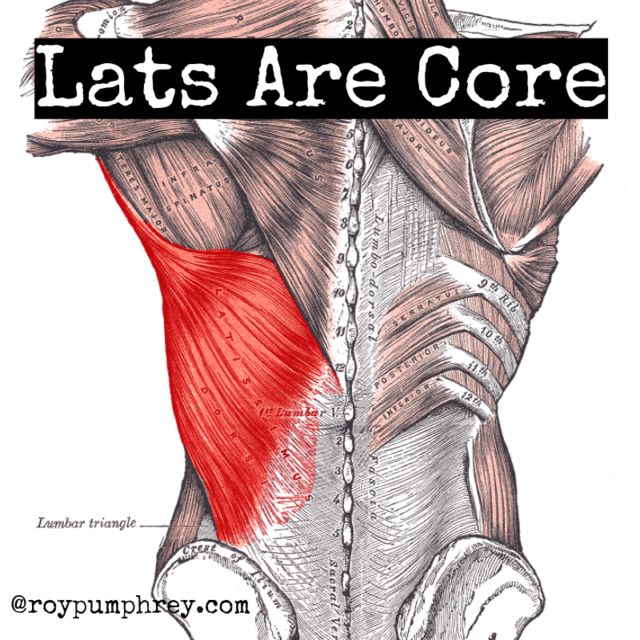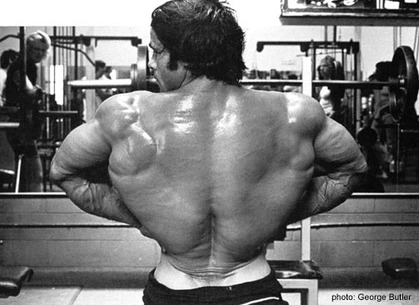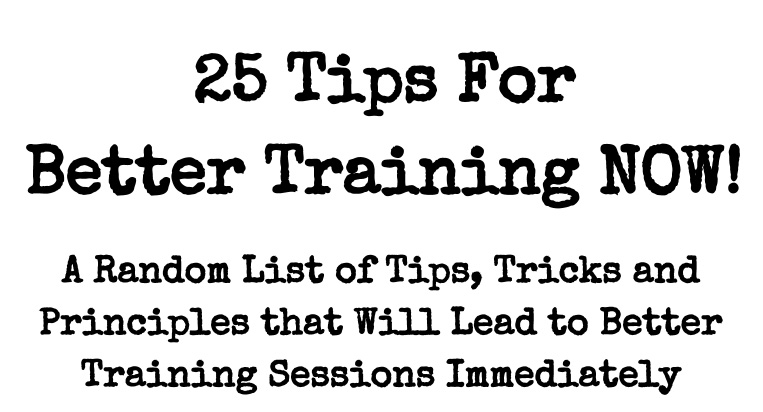
“You’ve Got a 400lbs Squat cause You’ve Got 600lbs Legs.
But 400lbs Abs” – Louie Simmons, Via Dave Tate
See, the key to lifting big weights, athletic performance and staying injury free is, in part, moving the correct thing, at the correct time.
The forgotten (or more often ignored) part of that statement is…
NOT MOVING WHAT SHOULDNT MOVE.
or more accurately
Not ALLOWING What Shouldn’t Move To Move.
This part of the equation is EQUALLY and maybe MORE important.
If stuff starts moving, under heavy loads, at high velocities or positions of great instability/ challenge.
YOU’R DONE
And in my opinion probably exponentially exposed to tissue deformation and injury.
But that’s just me, and I can’t really prove it.
Just makes sense me thinks.
Point is:
The Body Is An Interconnected Chain
During ALL movements, and especially evident during athletic, ground based, movements there is an interplay of the entire body from the toes through the eyes.
All muscles communicating and coordinating actions, tensions, forces and angles to create the desired (or undesired) movement(s).
The “Core” is What Connects The Upper and Lower Segments of the Body During These Movements.
I’m gonna lay some heavy science shit on you now so buckle up:
I had a physics professor at Towson.
He was an actual former Soviet Nuclear Scientist.
Not the Chernobyl kind.
The, send bombs to DC to rid the workers of the world from the evil capitalist overlord pig kind.
He had both a heavy Russian accent and a deep love for all things related to 50’s-70’s era beach culture.
The Ventures were his favorite band.
He drove a Woody and tried, poorly, to play the electric guitar.
Day one of class, the first thing he says is,
“Welcome”
The second,
“All the matter in the known universe was once contained in an area the size of an atom”
The other day I was on the Powerathlete HQ Instagram page wasting time researching training methods when I read,
“You Have a Core, Athletes Have A Trunk”
Mind Blown #broscience
Yes, I may have overstated the power of the singularity and universal expansion and understated the power of the core vs trunk.
For Functional, Athletic, Purposes,
It’s not a “core”,
It’s a should be big ole, thick ass,
TRUNK.
We’re not thinking about just your 6 pack abs and your tan.
But instead how do we transfer massive forces THROUGH the body to #bethehammer
We do it by training the whole core TRUNK.
Not just the “abs”.
What does that mean?
Much more.
Lats Are Core
The lats are one of the largest muscles in the whole human body.
While not necessarily incredibly thick, they cover a HUGE area.
 They attach on the front of the arm humerus and on the thoracic spine and scapula and again on the upper pelvis.
They attach on the front of the arm humerus and on the thoracic spine and scapula and again on the upper pelvis.
“Origin of the latissimus dorsi is from spinous processes of thoracic T7–T12, thoracolumbar fascia, iliac crest and inferior 3 or 4 ribs, inferior angle of scapula and insertion on floor of intertubercular groove of the humerus” – Variation in the insertion of the latissimus dorsi & its clinical importance
The “Function” of the Lats
The “lats” are generally seen as having 3 functions:
- Shoulder internal rotation
- Shoulder extension
- Shoulder adduction
But remember, half of quality, athletic, movement is NOT ALLOWING MOVEMENT.
“Too often we’re focused solely on what a muscle does concentrically (i.e., when it’s shortening), versus what it does eccentrically (i.e. when it’s lengthening).
So while all of the above is true, we could also say the lats:
Resist or control shoulder external rotation,
Resist or control shoulder flexion, and
Resist or control shoulder abduction.” – Mike Robertson“
What About Those Attachments at The Pelvis?
“Since the latissimus dorsi originates on the pelvis and sacrum, a proportion of its fascicles have the potential to extend the lower back. Moreover, since the muscle is in two parts (one on each side of the body), those same fascicles can function as a lateral flexor of the lower back, on either side” – Chris Beardsley
So wouldn’t it makes sense that based on this attachment and the placement of the lats they would also be excellent at resisting or controlling lumbar extension and lateral flexion?
While they’re not a primary lumbar extensor or lateral flexor, but we’re not talking about CREATING movement right now.
We’re talking about STOPPING/ CONTROLLING movement.
“Shoulder Blades in the Back Pockets”
I say that a LOT
Know why?
Because it helps “pack” the shoulders.
Why is that important?
- Shoulder health <— in a packed position you’re less likely to impinge the shoulder in pressing movements.
-
TRUNK stiffness increases
Putting the scapula “in the back pockets” (depression of the scapula), contracts the lats (remember that attachment on the inferior edge of the scapula).
Pulling the scapula down, “into the back pockets”, locking the humerus and scapula in place results in the stiffening a large swath of the posterior aspect of the TRUNK from the ribcage to the pelvis.
Wait But What?
The lats connect the upper (shoulder) and lower (pelvis),
Kinda like the rectus abdominus (6 pack abs) on the anterior and the Obliques on the lateral anterior and sides .

Look at the position of the lats relative to the abdominals, how are they not “core”?
If not core, they sure as hell are part of the TRUNK.
Putting it All Together.
I would argue that the ability to resist or control lumbar extension and lateral flexion combined with the ability to control of the shoulder (humerus and scapula together) is precisely why the lats are core.
The lats tie the upper and lower back together.
Controlling or at least contributing to stopping movement through the back side of the torso.
While there are MANY who disagree with this assessment and would argue the lats are NOT part of the “core” because they contribute little to lumbar extension and lateral flexion.
“The “core,” also referred to as the lumbopelvic-hip complex, is a 3-dimensional space with muscular boundaries: diaphragm (superior), abdominal and oblique muscles (anterior-lateral), paraspinal and gluteal muscles (posterior), and pelvic floor and hip girdle (inferior). The inherent nature of these muscular boundaries produces a corset-like stabilization effect on the trunk and spine.” – Core Stability Training for Injury Prevention
No mention of the lats in there?
We always have to remember that the ECCENTRIC and ISOMETRIC functions of the muscle are always just as important as the concentric.
People who Deal with Massive Forces think Lats are Core
“The muscles that surround our spine are considered the “core” of our body. It is composed of the abdominal muscles on your front and sides, the erector muscles of the back and even the larger muscles that span multiple joints (like the lats and psoas muscles).” – Dr. Aaron Horschig
“Your lats are actually powerful stabilizers of the lumbar spine. As Stuart McGill has discussed in Ultimate Back Fitness and Performance and his seminars, core stability is about the synergistic contribution of several muscles that all fire simultaneously to stabilize our spine. Through its attachment on the thoracolumbar fascia, the lats have an important influence on ensuring multi-directional stability at the lumbar spine.” – Eric Cressey
If You’re Gonna Use The Lats As Stabilizers You Gotta Train Them That Way
Step 1: If You Feel It, It Will Come
The biggest problem I see when it comes to using the lats as stabilizers is that people just don’t even know how to activate/ feel them.
If you’ve never felt a lat fire before, how the hell are you going to preferentially use it?
You’re not.
So we need to rectify that.
Rows and Pulldowns:
 Humble Opinion(s):
Humble Opinion(s):
- Rows are awesome and you NEED to do MORE in your program.
- Pulldowns are good, but for most people you should actually (as a ratio to rows) do less.
- Both are pretty good, when the CORRECT VARIATIONS are chosen and performed APPROPRIATELY teaching the “mind muscle connection” to the lats.
- They are, however, really sh@tty at teaching people how to use the lats as stabilizers.
So, why do them?
Like I said, you’re not going to understand how to fire the lats in a squat, bench, dead, carry or swing, if you’ve never FELT them at all, ever.
So we need to walk before we run.
The KEY to Feeling Your Lats in These Exercises:
NEVER allowing humeral approximation.

The minute the head of your humerus rotates forward, you’re probably out of the lats and into the biceps and rear delts.
You actually might still be in the lats here.
Some bodybuilders would argue that this is actually EXACTLEY how you should row to stay ONLY in the lats and out of the traps and rhomboids.
And they’re right.
BUT, they usually have TREMENDOUS mind- muscle connection and don’t default into pulling with the biceps.
Most of us normies, we pull with 100% biceps if we don’t force scapular retraction.
Plus we need to focus on “packing” the shoulder here if we’re going to use the lats as core TRUNK stabilizers.
Universal things to Focus on:
- “Pack” the shoulders. Remember this “packing” is partially (depression of the scapula) done by the lat contracting. It’s literally pulling the scapula down. So, shoulder blades in the back pockets at the
midpoint.
- Use the right amount of weight that allows for a slight pause (with the shoulder fully packed) at the midpoint (chest/ ribcage) of the lift.
- Try to maintain a vertical humerus through the midpoint of the movement. <—–IF you have excellent activation and shoulder mechanics (full scapula retraction) you’ll probably actually be forced into a very slight humeral approximation at the very end range, but for you, it wont matter. If your scap barely moves, it matters and don’t allow the humerus to “tip” forward.
Bro Tip:
Do Seated Band Rows
If someone has trouble feeling their lats, these work about 75% of the time.
Not sure why, probably has to do with the band(s) force curve (exponentially increasing instead of being more linear with bells or cables) and a poor motor pattern (not being strong or active enough in the rear delts and rhomboids to retract the scapula at the beginning of the movement to “get it out of the way”).
Train the Lats to “Pull Back and CRUSH the Sides”:
I don’t even know what that means.
But I do know that, that is EXACTLEY what a good rep of straight arm lat pulldowns feels like.
#backabs
But really like #backobliques
Straight Arm lat Pulldowns:
When done correctly nothing trains this function of the lats better.
Nothing.
Do a single rep of these correctly and your lats will LIGHT UP and you’ll feel them crush the sides and LOCK you in at the bottom.
Bro Tips:
- Have trouble “feeling” them. Hook the wrist on the bar <—-yes, the weight will be light, but that’s not the point yet.
- Its called a straight arm lat pulldown for a reason. Don’t turn it into a crappy triceps pressdown
- Elbows should be “soft” but near straight and that angle LOCKED in the whole time.
- Keep the wrists straight through the motion.
- Generally, I like to “match” the angle of the torso to the angle of the cable or band <—–Not exactly, but kinda/ sorta the same angle.
- Hold the bottom for a count of 1-5 once you can activate those lats and really SQUEEZE the hell out of them to sear that feeling of the lats activating and locking you down in your mind.
Tie the Lats into the Trunk:
You’ve built some lats
You can feel the lats,
Now, use the lats as part of the TRUNK.
RNT Band Resisted RDL’s:
See what the band does?
It pulls the bar away from you.
To perform any loaded hinge correctly we need to keep the bar as close to us as possible so we shorten the moment arm on the lumbar spine.
How do we do this?
ACTIVATING THE LATS to pull the bar into us the whole time.
What does this Pulling the bar in by Activating the Lats look and feel like?
EXACTLEY like the bottom of a straight arm lat pull.
You can do this with Deadlifts too:
And Bench:
Before you ask,
YES, you should be/ think about, activating the lats and PULLING the bar into you, keeping the upper back tight and scaps packed, when you bench.
While the lats play a small role in actually pressing the bar, they play a HUGE role in stabilizing the bar, maintaining the bar path and keeping the upper back and core stable, providing a better platform to press off of.
Dropping or riding the bar down to the chest is passive.
And in the weight game.
Passive = Wrong
Once you have a good feel for pulling the bar in, turning the lats on and keeping the lats on its time to level this skill up and really get tight.
Truly maximal lat activation and a truly super stiff trunk is achieved once you’ve leared how to “bend the bar”.
Bending the Bar = Super Charged Lats and SUPER STIFFNESS
Still Think Lats Aren’t Core?
If you never lift anything heavy.
If you never do anything at high velocities,
Maybe you don’t need your lats to create superstiffness in order to create and maintain a stable spine.
But if you are going to pick up something heavy, carry something heavy, put a heavy bar on your back, press some real weight or do anything at high force/ high velocity?
You’ll find out real fast how valuable the lats are and how much they can contribute to your ability to lock down and create a super strong TRUNK to transfer forces.
Here’s a bad ass picture of Franco Columbu, cause he’s generally considered to have one of the greatest set of lats ever and it’s a sick picture:




[…] Upper Back […]